EXSS380: Neurons and Synapses
1/131
Earn XP
Description and Tags
QUIZ 1
Name | Mastery | Learn | Test | Matching | Spaced |
|---|
No study sessions yet.
132 Terms
Define Motor Control
The study of how the neuromuscular system initiates and coordinates muscle activity to produce movement
What are 5 origins of disability?
societal limitations
disability
functional limitations
impairments
pathophysiology
Motor control and motor learning are sub-disciplines of two areas:
Neurophysiology and psychology
Motor skill
an activity that requires voluntary movement to achieve a goal
what are the three types of motor skill development?
skill acquisition: learning something for the first time
skill refinement: enhancement of prior skill, improvement
skill reacquisition: regaining skill following injury and disease, rehabilitation
motor development
changes in motor behavior over the lifespan, the processes that underlie these changes, and the factors that affect them
What are the main roles of nerve cells?
perception of the world
fix attention
control actions
How many individual nerve cells do we have?
100 billion
What is the purpose of neuroscience?
explaining the ability of individual neurons to influence behavior
gaining insight on the complexity of the nervous system
What are the 3 functions of the nervous system?
Sensory: sensing changes in the internal and external environment
Integrative: analyze data, store data, decide which stimuli are important
Motor: respond to stimuli through muscular contractions or glandular secretion
What are the two divisions of the Principle Nervous System?
CNS: central nervous system
PNA: peripheral nervous system (spinal, cranial)
What are the divisions of the CNS?
brain
spinal cord
What are the divisions of the Peripheral Nervous System?
Autonomic Nervous System: involuntary, connected to smooth/cardiac muscle or glands
Somatic Nervous System: voluntary and reflective muscle activity to skeletal muscle only
What are the two subdivisions of motor stimuli in the Autonomic Nervous System?
either excitatory (sympathetic) or inhibitory (parasympathetic)
all motor stimuli are _________ in nature
excititory
What is the role of glial cells?
Glia = support cells (“glue”)
they provide structure as well as seperate and insulate synaptic connections
remove debris after neuronal death
direct growth and release growth factors that nourish neurons
regulate the properties of presynaptic terminals
prevent toxic substances in the blood from entering the brain
Which are more numerous: glial cells or neurons?
glial cells are 10-50x more numerous than neurons
Microglia
phagocytes that are mobilized after injury, infection, or disease
Macroglia
Oligodendroctyes, Schwann cells, Astrocytes
Oligodendrocytes envelop how many axonal internodes? How about Schwann Cells?
O (CNS): about 15
S (PNS): a single internode 1mm long
What are the most numerous of all glial cells?
astrocytes
What are 3 roles/qualities of astrocytes?
permeable to potassium
maintain potassium ion concentration in the extra cellular space
clear excess neurotransmitters
What is the functional unit of the nervous system?
Neuron
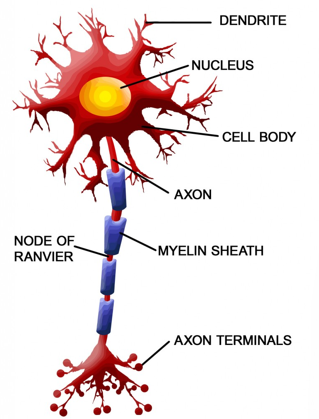
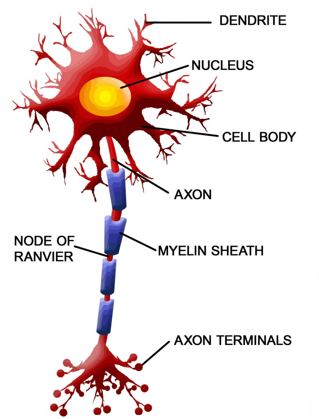
What is the metabolic center of the cell?
Soma
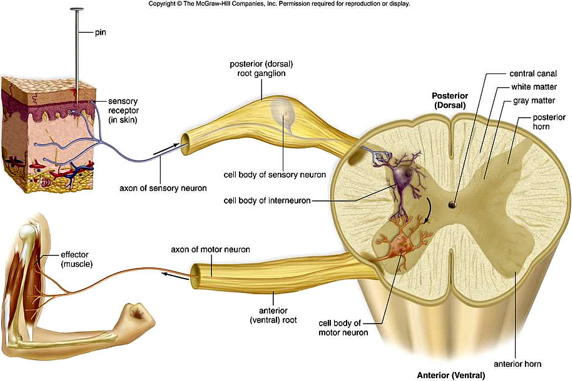
What are the functions of dendrites?
input to the neurom
conduct nerve impulses toward the cell body
relay information from external environment
What is the function of the axon?
The long, thin, cylindrical process joins the cell body at the axon-hillock:
transmit nerve impulses away from the cell body to other neurons, muscle fibers, glands, etc.
The nodes of ranvier function like:
an express train, allowing signals to pass by channels without having to stop at each one
True or false: presynaptic cell touches the post-synaptic cell
FALSE: they do NOT touch
How often do the following pre-synaptic terminals communication on the post-synaptic terminals
dedrites
soma
axon
most often
occassionaly
rarely
Synapse
the point where two neurons communicate, composed of the presynaptic cell, postsynaptic cell, and synaptic cleft
Principle of dynamic polarization
electrical signals within a nerve cell flow in only one direction
Principle of connection specificity
neurons do not connect indiscriminately, rather making specific connections at particular points (no networks at random)
Orthodromic vs. Antidromic
Orthodromic: propogation along the acon in the normal physiological direction (ex: in an effect nerve, this is away from the soma
antidromic: propogation of an action potential in the opposite direction of orthodromic conduction (ex: this could happen with a strong enough mechanical stimulus to disrupt flow, like hitting your funny bone)
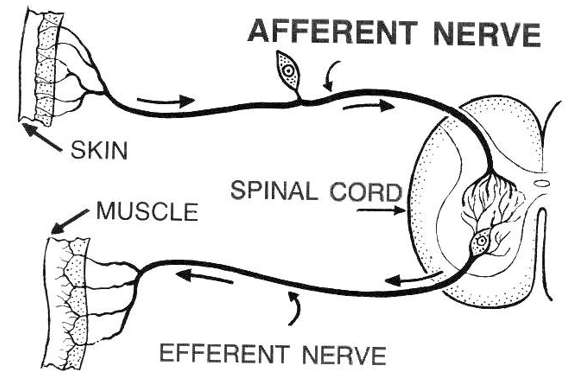
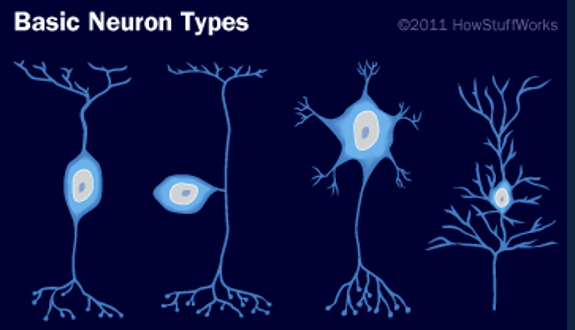

What are 3 types of neurons?
sensory
motor
interneurons
Nerve Fiber
neuronal process, like dedrite or axon
nerve definition
a bundle of nerve fibers in PNS
tract definition
a bundle of nerve fibers in CNS
Nucleus definition
cluster of nerve cell bodies in CNS
Ganglion
cluster of nerve cell bodies in PNS
what are 4 steps to a neuron affecting another neuron or an effector organ?
neurotransmitters alter the status of the post-synaptic membrane (excitatory or inhibitory)
Soma generates an “on” signal (action potential)
AP travels away from the soma via axon
AP causes the release of neurotransmitters
how does the tranmission of neural information make it in and out of cells?
information transfers based on the rapid changers in the electrical potential across cell membranes; the movement of charged particles (ions) governed by excitable membranes surrounding the cells.
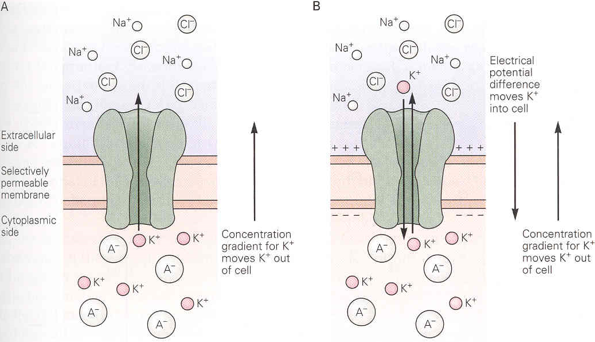
How do ion channels function?
They recognize and select specific ions, opening and closing in response to specific electrical, mechanical, or chemical stimuli
Resting membrane potential
when inactive, a membrane will have an electrical potential of -60/-70 mV in nervous tissue and -80 in skeletal tissue
What charge do the inside/outside of the cell have?
inside: -
Outside: +
Excitation and inhibition are caused by:
changes in resting potential
Where are Na+ and Cl- concentrated?
outside the cell
Where are K+ and organic anions (-) concentrated?
inside the cell
What are 3 ways that the resting membrane potential is maintained?
concentration gradient: there are more K channels than Na channels, so there will be more K going out than Na coming in
nongated channels: the nongated K channels leak potassium ions out from the neuron, and the nongated Na channels leak sodium ions into the neuron
sodium potassium pump: this moves Na out and K into the cell
Inside/outside of the cell have more _____ and a ________ charge
inside; more K+, negative
outside: more Na+, positive
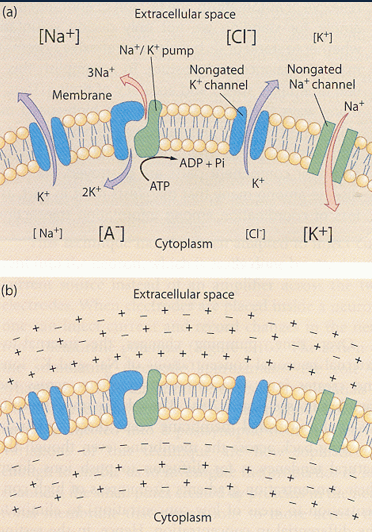
Action Potential
an action potential is generated when depolarization of a cell reaches threshold because of an Na+ influx
All or Nothing Phenomenon
once a membrane reaches threshold, it will always have the same strength action potential regardless of the strength of the signal when it got there
Action potential phases
depolarization
overshoot
repolarization
hyperpolarization
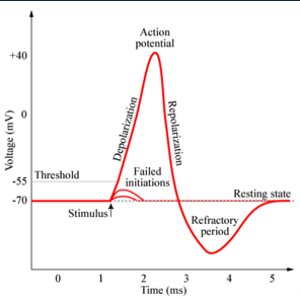
describe action potential conduction
occurs via propogation
flows to neighboring areas, creating new APs in adjacent segments (either on or off, all-or-none, meaning that adjacment segments will have identical APs)
hyperpolarization
extreme polarization following peak of AP, prevents action potential from occuring
essential period for the membrane to recover and be able to generate subsequent action potentials
allows for AP propogation by preventing backfire
What receives information from neurotransmitters?
dendrites
EPSP causes soma to generate:
Action potential:
selective membrane permeability altered
rapid influx of Na
depolarization
AP causes the release of:
neurotransmitters, influencing the next postsynaptic membrane
what transmits neural information to the skeletal muscle?
motor neuron
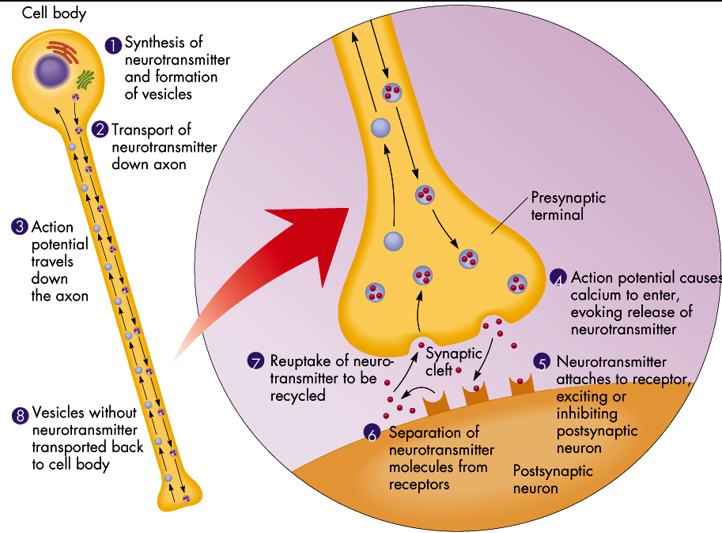
Motor Unit
a single motor neuron and all the muscle fibers it innervates
what is the smallest controllable neural component?
motor unit
what determines the level of control of a motor unit?
the number of fibers innervated
a muscle contraction occurs when a motor unit releases ____ and creates ______
acetylcholine (ACh)
end plate potential (EPSP)
Excitation coupling produces:
contraction: TWITCH
it can vary in contraction time and peak force
2 neural mechanisms for increased contraction force
rate coding: firing frequency
motor unit recruitment: # of active motor unites
twitch
mechanical response to single stimulus
tetanus
sustained maximal tension due to high frequency stimulation
Henneman Size principle
Motor units will always be recruited from smallest to largest, determined by a motor units size
the reduction of tension (relaxation) will be accomplished in reverse order
this allows for smooth changes in contractile forces

Fiber Type Comparison: I, IIa, IIb
fiber type affects muscle force, rate of force production, and recruitment order

Describe the role of sensory neurons
Sense changes in the internal and external environment]
Highly specialized nerve type: response to a VERY specific stimulus
Ex; optic, senses light, we interpret that to some type of figure. The sensory nerve only takes part in the sensing process and only light
Ex; Olfactory: smell something, interpret what the scent is, the sensory neuron only does the smelling, not the association, and only the scent
Describe the role of integrative neurons
Analyzes data
Stores data
Decide which stimuli are important
describe the role of Motor neurons
Responses to information from the CNS, respond to stimuli through muscular contractions or glandular secretion
Schwann cells change how ____ the action potential can travel
fast; speed up!
tissue structure that makes up Schwann cells
myelin
Schwann cells increase:
conduction velocity
where are neurotransmitters made?
soma
where does an action potential start?
axon hillock: the neck looking part of the axon
what charge does the axon hillock have to reach to begin an action potential?
-55 mV
does the size of the soma affect an action potential?
the smaller the neuron, the more likely it is to overflow. Same amount of Na/excitation will be much easier to come to depolarization if it is smaller, think about like filling a small cup vs. large glass
what is the only nerve type located outside the CNS?
sensory: more vulnerable to injury, protected by the vertebrae
the sensory neurons come in the ____ side, the motor neuron in the ______ side, and the soma ________
posterior, anterior, within the CNS
what moves information away from the soma?
axon
what brings input into the neuron/toward the soma?
dendrite
true or false: every neuron is excitatory
false
can neural signals decay?
Neural signals do not decay, they just propagate
Nodes of Ranvier
space between the nodes/myelin sheaths
why are the ends of neurons swollen?
swollen at the end of the neuron: more gates, larger surface area means more neurotransmitters sending out to more places, more efficient because it mechanically functions better, vesicles have room to travel down, dump, and head back up. Also allows for more exit sites to influence the post synaptic cleft
are sensory and motor neurons afferent or efferent?
Afferent: sensory
efferent: motor
what are the orthodromic directions for sensory and motor neurons?
Sensory: away from the receptor, toward the CNS
motor neuron: away from the CNS, toward the muscle
what are the antidromic directions for sensory and motor neurons?
sensory: away from the CNS, toward the receptor
you would not be able to feel pain because it is using the pathway, so it cannot send a normal orthodromic response
motor: toward the CNS, away from the muscle
would cause inability to utilize motor neuron to contract the muscle, collides with the other response
how do you know something is capable of excitation?
it is charged
are their more potassium or sodium channels?
Double the amount of potassium channels: it will leak out more than sodium is going to come in. That means that it will trend positively, lower threshold
can you have an AP begin in a non-resting state?
yes, you can during refractory period, you just need a stronger stimuli to get it to threshold
what is the easiest way to depolarize a cell?
let sodium in, most positively charged ion